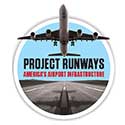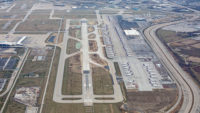The term “NextGen” in airport lingo traditionally refers to the next generation of air traffic control. But “next generation” could apply to any number of airport infrastructure challenges ahead, including the next wave of disruptive technology, the changing habits of future travelers and increasing concerns about attracting a new crop of talent.

Airport owners also are facing the next cycle of major renovations and expansions as the number of people using air travel worldwide is expected to double from 3 billion in the next couple of decades.
“These are very challenging times,” said Mario Diaz, director of aviation for the Houston Airport System. “We have mergers, fuel economics [and] more travel, and terrorism is raising its ugly head again,” he told attendees at the American Association of Airport Executives’ annual meeting this month in that city. “We have the traditional problems of modernizing [and] expanding and the never-ending problem of how to finance them.”
ENR interviewed several airport veterans on the exhibit floor in anticipation of its tour across America’s aviation infrastructure this year.
Engineering New Talent
“Technology is changing at a rate it never had before,” says William Peduzzi, aviation market-segment director for CH2M. “I have the world available on my phone—we’d better have that at an airport.”

“When I was in college, I didn’t know airport engineering was a thing.”
— William Peduzzi,
CH2M aviation market-segment director, talking about the challenge of recruiting new talent to the industry.
Technology is not only changing travelers’ expectations of an airport; it also is creating competition for the next generation of engineering talent, Peduzzi adds. “Transportation, in general, has tremendous opportunities, but it suffers from not being a Google or Apple.” He admitted, “When I was in college, I didn’t know airport engineering was a thing.”
Jayne O’Donnell, general manager of aviation for Turner Construction Co., notes that new company hires like the urgency associated with major airport projects: “ ‘Today, I have to save the world again,’ they tell me. ‘The field guys have the most exciting jobs,’ ” she says. “The downside is that you often have to [relocate].”
Attracting new talent is a must in order to keep up with burgeoning air traffic. Airports in Orlando and Las Vegas are a “canary in the coal mine,” reflecting the economic upsurge, says Ben Siwinski, senior airport planner with VHB. “These airports have been picking up in the past couple of years. If you want to see how the economy is now, look at those airports.”
Other major hubs also are working on the next generation of master plans. Atlanta Hartsfield-Jackson International Airport, the world’s busiest airport, is embarking on a $6-billion modernization program that includes a terminal clad in new-wave materials, such as ETFE (ENR 11/3/14 p. 56). Next year, work will begin on a $5-billion landside-access project at Los Angeles International Airport as part of an overall $14-billion program. Salt Lake City’s airport, which ENR visited last year as part of its “Low & Slow Across America’s Infrastructure” tour, is ramping up a $2.6-billion program. And work is beginning on a $5-billion overhaul of LaGuardia airport’s central terminal through a first-of-its-kind public-private partnership in the U.S.

“Today, I have to save the world again.”
— Jayne O’Donnell,
Turner general manager of aviation, quoting new employees describing why they are enthusiastic about airport construction jobs.
Mid-tier airports have big infrastructure need, too, but face the additional challenge of a merger-mad industry that has resulted in fewer airlines that can serve as anchor tenants. “What do you do when the business model has changed?” says Siwinski. “You have to become a [land] developer.”
In that vein, the Indianapolis airport built a 20-MW solar farm that sells power to the local utility, says Reggie Henderson, vice president with Telamon Energy Solutions, which provided funding and development assistance.
Disruptive Technology
The increasing connectivity of devices and sensing systems, movement analytics and heat maps will influence airport asset maintenance, said Manik Arora, president and CEO of Arora Engineers, speaking on one of the many technology panels. Airports also are experimenting with facial recognition technologies to improve passenger flows and security.
Aviation-sector veterans cited driverless vehicles as perhaps the biggest game-changer ahead. “Of all the emerging technologies, the advent of autonomous vehicles … will have sustained impact on airport operations and finances,” says Allan Shapiro, senior management consultant at Ross & Baruzzini. “Airports will have to take into consideration the impact of passengers using autonomous vehicles to access and depart them,” he adds. “Driverless cars will impact major sources of revenue that airports once received from parking, car rental operations and taxis, as well as terminal curb-frontage management.” Driverless vehicles could spur the construction of remote smart garages in which the vehicles could park between trips, Shapiro notes.
Adds Siwinski, “Autonomous vehicles will be twice as disruptive as Uber.”





Post a comment to this article
Report Abusive Comment